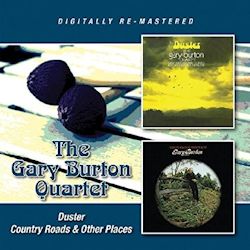Duster
Ballet
Sweet Rain
Portsmouth Figurations
General Mojo’s Well Laid Plan
One. Two 1-2-3-4
Sing Me Softly of the Blues
Liturgy
Response
Country Roads and Other Places
Country Roads
The Green Mountains
True or False
Gone. But Forgotten
Ravel Prelude
And on the Third Day
A Singing Song
Wicjhita Breakdown
My Foolish Heart
A Family Joy
Duster:
Gary Burton (vibes): Larry Coryell (guitar): Steve Swallow (bass): Roy Haynes (drums)
Country Roads
: Gary Burton (vibes): Jerry Hahn (guitar): Steve Swallow (bass): Roy Haynes (drums)
Recorded 1967 and 1969
[68:01]
BGO has done well to restore these two LPs onto a single CD. Gary Burton’s quartet was a solid ensemble – how could it not be with Coryell, Swallow and
Haynes – when it made Duster in 1967. Its accommodation of varying stylistic musics may to some seem frivolous or retrogressive but in fact the
Jazz-Rock-Country roads taken by the quartet sound convincing in their own way. The sense of lyrical iridescence, too, that is part of the 4-hammer wash of
Burton’s playing, not least on the tracks penned by Mike Gibbs, proves compelling too. Swallow’s General Mojo’s Well Laid Plan reveals his own
immersion in Country feel but not one that ever feels forced or clichéd. A faster Bop aesthetic can be heard in his harder-edged soloing on One. Two 1-2-3-4 where Swallow and Haynes drive the rhythm with flexible drama and where Burton solos with virtuosic speed but also a sure sense
of colour.
Country Roads and Other Places
followed two years later and saw the replacement of Coryell by Jerry Hahn. There was no let-up in that fruitful nexus between a light Bluesy feel and
Country. The album, in fact, isn’t particularly Jazz versed preferring to explore softer laid back elements, as the album title suggests. It’s interesting
to hear the overdub on the Ravel Prelude – actually from the Frenchman’s Le Tombeau de Couperin – where Burton wields the mallets but
overdubs on piano as well. Throughout this second album, in particular, there is a sense of serenity in the playing, to which Hahn contributes well. The
moods covered in these two albums, whether slow-moving, more kinetic, or colour-drenched – always reflect well on the musicians.
Only one small complaint: I wish BGO, which provides excellent notes, provided more precise recording details.
Jonathan Woolf
